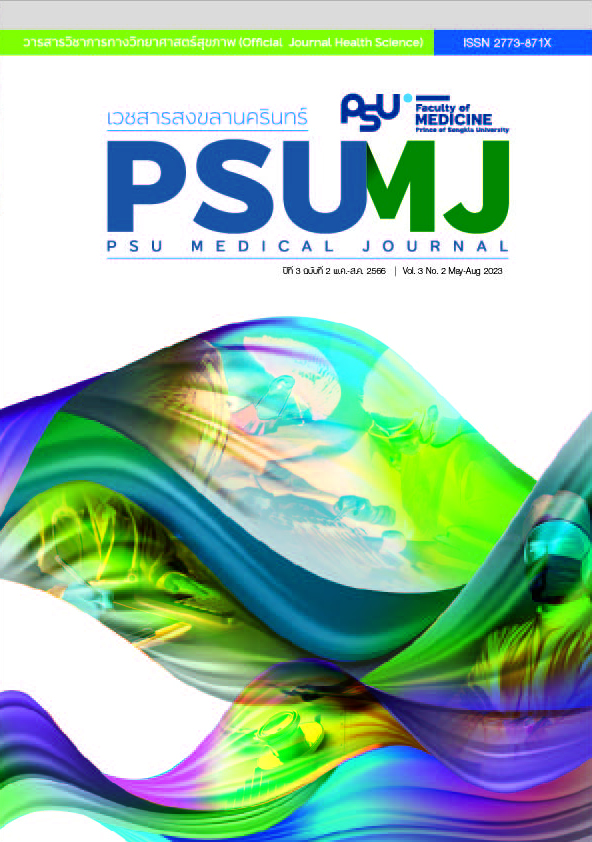Selection of Appropriate Methods Analysis of Cytotoxicity Assay for In Vitro Study
Selection of Cytotoxicity Assay for In Vitro
DOI:
https://doi.org/10.31584/psumj.2023254768Keywords:
cell viability, ytotoxicity, in vitro studyAbstract
Cell viability is defined as the number of living cells and the proliferation of cells. It is a vital indicator for understanding mechanisms of action and cytotoxicity that involve cell survival or cell death following exposure to agents, including crude extract, pure compounds and drugs. A broad spectrum of cytotoxicity assay is currently used to estimate toxicology and pharmacology. In fact, methods used to determine viability are typical for the detection of cell growth and cell proliferation. Therefore, cytotoxicity assays are essentially utilized for agent screening to detect whether the test molecules affect cell proliferation or directly display cytotoxic effects. Accumulating evidence demonstrated that regardless of the cell-based assay being used, it is crucial to know how many viable cells remain at the end of the experiment. There are various assay methods based on various functions, such as evaluating structural cell damage (non-invasive and invasive) by cell counting assay, measuring cellular metabolism activity, and determining deoxyribonucleic acid and adenosine triphosphate contents. However, there is no conclusion on whether any method is most accurate and appropriate. Since every research has differentiations and limitations, choosing the proper viability assay, the cell type, the constituent molecule of the substance, concentration and even the extraction method should be considered. This particular review aims to provide information on different cytotoxicity assays together with their own advantages and disadvantages. Additionally, it may be possible to select the appropriate agent concentration, have no false-positive results, and increase the reproducibility of their research design.
References
Berridge MV, Herst PM, Tan AS. Tetrazolium dyes as tools in cell biology: New insights into their cellular reduction. Biotechnol Annu Rev 2005;p.127-52.
Präbst K, Engelhardt H, Ringgeler S, Hubner H. Basic Colo-rimetric proliferation assays: MTT, WST, and resazurin. Methods Mol Bio 2017;1601:1-17.
Stockert JC, Horobin RW, Colombo LL, Blazquez-Castro A. Tetrazolium salts and formazan products in cell biology: viability assessment, fluorescence imaging, and labelin per-spectives. Acta Histochem 2018;120:159-67.
Mosmann T. Rapid colorimetric assay for cellular growth and survival: application to pro liferation and cytotoxicity assays. J Immunol Methods 1983;65:55-63.
Ulukaya E, Colakogullari M, Wood EJ. Interference by anti-cancer chemotherapeutic agents in the MTT-tumor chemo-sensitivity assay. Chemotherapy 2004;50:43-50.
Ulukaya E, Ozdikicioglu F, Oral AY, Demirci M. The MTT assay yields a relatively lower result of growth inhibition than the ATP assay depending on the chemotherapeutic drugs tested. Toxicol In Vitro 2008;22:232-9.
Peng L, Wang B, Ren P. Reduction of MTT by flavonoids in the absence of cells. Colloids Surf B Biointerfaces 2005; 45:108-11.
Lü, L, Zhang L, Wai MS, Yew DT, Xu J. Exocytosis of MTT formazan could exacerbate cell injury. Toxicol In Vitro 2012; 26:636-44.
van Tonder A, Joubert AM, Cromarty AD. Limitations of the 3-(4,5-dimethylthiazol-2-yl)-2,5-diphenyl-2H-tetrazolium bromide (MTT) assay when comparedto three commonly used cell enumeration assays. BMC Res Note 2015;8:47.
Tahara H, Matsuda S, Yamamoto Y, Yoshizawa H, Fujita M, Katsuoka Y, et al. High-content image analysis (HCIA) assay has the highest correlation with direct counting cell suspen sion compared to the ATP, WST-8 and Alamar blue assays for measurement of cyto-toxicity. J Pharmacol Toxicol Methods 2017;88(Pt 1):92-9.
Ishiyama M, Miyazono Y, Sasamoto K, Ohkura Y, Ueno K. A highly water-soluble disulfonated tetrazolium salt as a chromogenic indicator for NADH as well as cell viability. Talanta 1997;44:1299-305.
Espino FE, Bibit JA, Sornillo JB, Tan A, von Seidlein L, Ley B. Comparison of three screening test kits for G6PD enzyme deficiency: implications for Its Use in the radical cure of vivax malaria in remote and resource-poor areas in the Philippines. PLoS One 2016;11:e0148172.
Gomez-Gutierrez JG, Bhutiani N, McNally MW, Chuong P, Yin W, Jones MA, et al. The neutral red assay can be used to evaluate cell viability during autophagy or in an acidic microenvironment in vitro. Biotech Histochem 2021;96:302-10.
Lu L, Li B, Ding S, Fan Y, Wang S, Sun C, Zhao M, Zhao CX, Zhang F. NIR-II bioluminescence for in vivo high contrast imaging and in situ ATP-mediated metastases tracing. Nat Commun 2020;11:4192.
Whyte C, Ma TF, Sindelar J, Rankin S. Rapid hygiene assay sensitive to cumulative adenylate homologues exhibits equal or higher frequencies of soil contamination detection than assay limited to ATP detection. J Food Prot 2021;84:1937-44.
Karakas D, Ari F, Ulukaya E. The MTT viability assay yields strikingly false positive viabilities although the cells are killed by some plant extracts. Turk J Biol 2017;41:919-25.
Riss TL, Moravec RA, Niles AL, Markossian S, Grossman A, Brimacombe K, et al. Cell viability assays. Assay Guidance Manual [monograph on the Internet]. Bethesda (MD: Eli Lilly & Company and the National Center for Advancing Translational Sciences; 2016 [cited 2022 Jan]. Available from: https://www.ncbi.nlm.nih.gov/books/NBK144065/
Thermofisher.com. Invitrogen, “Presto Blue cell viability reagent protocol,” Product information sheet by life technologies. [homepage on the Internet] Waltham: Thermo Fisher Scientific; 2012 [cited 2021 Dec 2]. Available from: https://www. thermofisher.com/document-connect/document-connect. html?url=https://assets.thermofisher.com/TFS-Assets% 2FLSG%2Fmanuals%2FMAN0018370PrestoBlueCellViability Reagent-PI.pdf
Louis KS, Siegel AC. Cell viability analysis using trypan blue: manual and automated methods. Methods Mol Biol 2011; 740:7-12.
Cadena-Herrera D, Esparza-De Lara JE, Ramírez-Ibañez ND, Lopez-Morales CA, Perez NO, Flores-Ortiz LF, et al. Validation of three viable-cell counting methods: manual, semi-automated, and automated. Biotechnol Rep (Amst) 2015;7:9-16.
Skehan P, Storeng R, Scudiero D, Monks A, McMahon J, Vistica D, et al. New colorimetric cytotoxicity assay for anti-cancer-drug screening. J Natl Cancer Inst 1990;82:1107-12.
Orellana EA, Kasinski AL. Sulforhodamine B (SRB) assay in cell culture to investigate cell proliferation. Bio Protoc 2016;6:e1984.
Kasinski AL, Kelnar K, Stahlhut C, Orellana EA, Zhoa J, Shimer E, et al. A combinatorial microRNA therapeutics approach to suppressing non-small cell lung cancer. Oncogene 2015;34:3547-55.
Sriwilaijaroen N, Kelly JX, Riscoe M, Wilairat P. Cyquant cell proliferationassay as a fluorescence-based method for in vitro screening of antimalarial activity. Southeast Asian J Trop Med Public Health 2004;35:840-4.
Lall N, Henley-Smith CJ, De Canha MN, Oosthuizen CB, Berrington D. Viability reagent, pres to blue, in comparison with other available reagents, utilized in cytotoxicity and antimicrobial assays. Int J Microbiol 2013;420601.
Boncler M, Rozalski M, Krajewska U, Podsedek A, Watala C. Comparison of PrestoBlue and MTT assays of cellular viability in the assessment of anti-proliferative effects of plant extracts on human endothelial cells. J Pharmacol Toxicol Methods 2014;69:9-16.
Gonzalez Gonzalez M, Cichon I, Scislowska-Czarnecka A, Kolaczkowska E. Challenges in 3D culturing of neutrophils: Assessment of cell viability. J Immunol Methods 2018;457:73-7.
Xu M, McCanna DJ, Sivak JG. Use of the viability reagent PrestoBlue in comparison with alamarBlue and MTT to assess the viability of human corneal epithelial cells. J Pharmacol Toxicol Methods 2015;71:1-7.
Altman SA, Randers L, Rao G. Comparison of trypan blue dye exclusion and fluorometric assays for mammalian cell viability determinations. Biotechnol Prog 993;9:671-674.
Jones LJ, Gray M, Yue ST, Haugland RP, Singer VL. Sensitive determination of cell number using the CyQUANT cell pro-liferation assay. J Immunol Methods 2001;254:85-98.
Downloads
Published
How to Cite
Issue
Section
License
Copyright (c) 2023 Author and Journal

This work is licensed under a Creative Commons Attribution-NonCommercial-NoDerivatives 4.0 International License.








